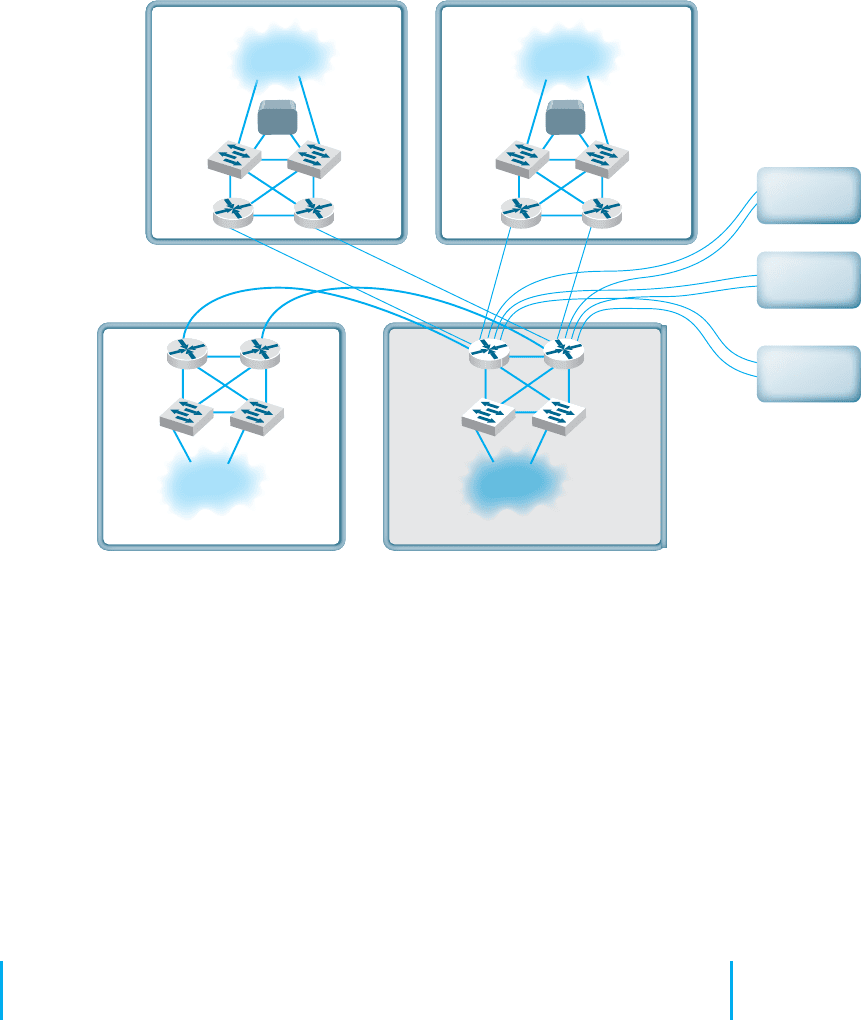FitzGerald J., Dennis A., Durcikova A. Business Data Communications and Networking
Подождите немного. Документ загружается.


11.5 DESIGNING FOR NETWORK PERFORMANCE 435
11.3
LOAD BALANCING
AT
BRYAM HEALTHCARE
MANAGEMENT
FOCUS
Bryam Healthcare is a medical supply company
serving more than 300,000 customers from 17
operating centers. When its sales representa-
tives began complaining about the slow response
times for email, Web, and other key applications,
Anthony Acquanita, Byram’s network manager,
realized that the network architecture had reached
its limits.
The old architecture was a set of four servers
each running specific applications (e.g., one email
server, one Web server). At different points in
the week, a different server would become over-
loaded and provide slow response times for a
specific application—the email server first thing
Monday morning as people checked their email
after the weekend, for example.
The solution was to install a load balancing
switch in front of the servers and install all the
major applications on all the servers. This way
when the demand for one application peaks,
there are four servers available rather than one.
Because the demand for different applications
peaks at different times, the result has been
dramatically improved performance, without the
need to buy new servers. The side benefit is
that it is now simple to remove one server
from operations at nonpeak times for mainte-
nance or software upgrades without the users
noticing (whereas in the past, server main-
tenance meant disabling an application (e.g.,
email) for a few hours while the server was
worked on).
SOURCE: ‘‘Load Balancing Boosts Network,’’
Communications News,
November 2005, pp. 40–42.
Web files closer to their own internal users, a content delivery provider stores Web
files for its clients closer to their potential users. Akamai, for example, operates almost
10,000 Web servers located near the busiest Internet NAPs, and other exchanges. These
servers contain the most commonly requested Web information for some of the busiest
sites on the Internet (e.g., yahoo.com, monster.com, ticketmaster.com).
When someone accesses a Web page of one of Akamai’s customers, special soft-
ware on the client’s Web server determines if there is an Akamai server containing any
static parts of the requested information (e.g., graphics, advertisements, banners) closer
to the user. If so, the customer’s Web server redirects portions of the request to the Aka-
mai server nearest the user. The user interacts with the customer’s Web site for dynamic
content or HTML pages with the Akamai server providing static content. In Figure 11.15,
for example, when a user in Singapore requests a Web page from yahoo.com, the main
yahoo.com server farm responds with the dynamic HTML page. This page contains sev-
eral static graphic files. Rather than provide an address on the yahoo.com site, the Web
page is dynamically changed by the Akamai software on the yahoo.com site to pull
the static content from the Akamai server in Singapore. If you watch the bottom action
bar closely on your Web browser while some of your favorite sites are loading, you’ll
see references to Akamai’s servers. On any given day, 15–20 percent of all Web traffic
worldwide comes from an Akamai server.
Akamai servers benefit both the users and the organizations that are Akamai’s
clients, as well as many ISPs and all Internet users not directly involved with the Web
request. Because more Web content is now processed by the Akamai server and not
the client organization’s more distant Web server, the user benefits from a much faster
response time; in Figure 11.15, for example, more requests never have to leave Singapore.

436 CHAPTER 11 NETWORK DESIGN
11.4
CONTENT CACHING AT THE SALT LAKE
CITY OLYMPIC GAMES
MANAGEMENT
FOCUS
The 2002 Olympic Winter Games in Salt Lake
City needed a network infrastructure that would
deliver real-time results, athlete biographies,
transportation information, competition sched-
ules, medal counts, competition results, and more
to thousands of users (media, Olympic athletes,
and staff) at sporting venues, Olympic villages,
administrative offices, media centers, and exter-
nal Web sites. The network had to guarantee maxi-
mum reliability 24 hours a day, seven days a week.
The Salt Lake City Olympic Committee
established a primary data center with two
high-performance load balancing switches in
a standby/failover configuration supporting a
server farm (see Figure 11.14) so that if one switch
failed, the standby switch would detect the failure
and automatically take over. The load balancing
capability of the switches ensured that incoming
traffic was routed to the least busy server, thereby
ensuring maximum performance.
The primary data center was connected via
a pair of routers (again in a standby/failover
configuration) through T-3 lines to a secondary
data center with a similar structure that would
be used in the event of problems with the pri-
mary data center. The primary data center was
connected via a pair of T-1 lines to the Media
Center, to the Athletes Village, and to each of the
10 Competition Venues.
The network at the Media Center, the Athletes
Village, and Competition Venues had a similar
standby paired router/paired switch configura-
tion, with the addition of a content engine to
reduce traffic over the T-1 lines to the primary
data center.
The resulting network design ensured max-
imum reliability due to the paired circuits/
routers/switches to all locations. The content
engines also provided increased reliability and
significantly reduced network traffic to the pri-
mary data center, thus reducing the capacity
needed by the circuits and servers.
SOURCE: ‘‘IKANO Deploys Cisco Content
Networking Solutions,’’ www.cisco.com, 2004.
The client organization benefits because it serves its users with less traffic reaching its
Web server; Yahoo! for example, need not spend as much on its server farm or the Internet
connection into its server farm. In our example, the ISPs providing the circuits across
the Pacific benefit because now less traffic flows through their network—traffic that is
not paid for because of Internet peering agreements. Likewise, all other Internet users
in Singapore (as well as users in the United States accessing Web sites in Singapore)
benefit because there is now less traffic across the Pacific and response times are faster.
11.5.5 Green IT
Green IT is the design and use of information technology to improve environmental
sustainability. Much of Green IT focuses on reducing the amount of power consumed
by and heat produced by network devices (because increased heat means the increased
need for air conditioning, which requires power). Some network devices (e.g., servers,
switches, routers) are designed to reduce power consumption and heat production. For
example, smaller devices tend to require less electricity than larger devices.
One of the most important steps in Green IT is server virtualization, which we
discussed previously. Server virtualization reduces the number of physical servers and
thus is likely to have a large impact. Fewer computers means less energy and less heat.

11.6 IMPLICATIONS FOR MANAGEMENT 437
Content
Engine
Router Router
SwitchSwitch
Media Center
LAN
Content
Engine
Router Router
SwitchSwitch
Athletes Village
LAN
Router Router
Server
Farm
Secondary Data Center
Switch Switch
LAN
Router Router
Server
Farm
Primary Data Center
Load
Balancing
Switch
Load
Balancing
Switch
LAN
Venue
Venue
Venue
FIG URE 11.14 Olympic network. LAN = local area network
The use of content delivery is a similar Green IT strategy, as it means fewer less-used
servers spread around the Internet.
Software can be installed that shuts off components within the device (e.g., a
monitor or hard disk) after a certain time of inactivity to save energy. The newest Ethernet
standard (IEEE 802.3az), for example, defines a change to the Ethernet protocol that
permits NICs and switches to go into sleep mode to save energy when not transmitting.
LANs are typically never used at 100 percent of capacity (most network circuits are
active less than 10 percent of the time), so there is considerable potential to cut energy
consumption.
Experts estimate that about 20 percent of the energy used in a typical office building
is generated by IT. Thus, moving to green IT can save significant operating costs, as
well as being better for the environment.
11.6 IMPLICATIONS FOR MANAGEMENT
Network design was at one time focused on providing the most efficient networks
custom tailored to specific needs. Today, however, network design uses a building-
block approach. Well-designed networks use a few common, standardized, network

438 CHAPTER 11 NETWORK DESIGN
Singapore
California
HTTP Response with
Web Page
HTTP Requests for
Static content redirected
to local server
HTTP Request
FIG URE 11.15 Network with
content delivery
technologies over and over again throughout the network even though they might pro-
vide more capacity than needed. Under ideal circumstances, the organization will develop
deep relationships with a very small set of vendors.
As the cost to operate and maintain networks gradually becomes more expensive
than the cost to purchase network technologies in the first place, good network design
commonly results in the purchase of more expensive equipment in order to save signifi-
cantly more money in reduced network management costs over the life of the network.
While there is a temptation to go with the lowest bidder and buy inexpensive equipment,
in many cases this can significantly increase the lifecycle cost of a network. The use
of sophisticated network design tools and network management tools has become a key
part of almost all new networks installed today.
11.5 CONTENT DELIVERY AT BEST BUY
MANAGEMENT
FOCUS
Best Buy operates more than 1150 retail elec-
tronic stores across the United States and Canada,
and has an extensive online Web store offering
more than 600,000 products. Its Web store hosts
more than 4000 million visits a year, more than
all of its 1150 physical stores combined.
Best Buy wanted to improve its Web store to
improve customer experience and reduce oper-
ating costs. Akamai’s extensive content delivery
presence in North America enabled Best Buy
to improve the speed of its Web transactions
by 80 percent, resulting in substantial increases
in sales. The shift to content delivery has also
reduced the traffic to its own servers by more
than 50 percent, reducing its operating costs.
SOURCE: Akamai Helps Best Buy, Akamai case
studies, akamai.com, 2008.

SUMMARY 439
11.6 IT’S EASY BEING GREEN
MANAGEMENT
FOCUS
Avnet, Inc., located in Phoenix Arizona, is one
of the largest distributors of electronic com-
ponents, technology solutions, and computer
products in the world. Through its supply chain,
Avnet connects the world’s leading technology
manufacturers with customers in more than
70 countries. Avnet was ranked for two consec-
utive years as No.1 in its industry by
Fortune
magazine’s list of ‘‘Most Admired Companies.’’
However, its success reaches beyond its special-
ization. Avnet is also one of the leaders in Green
IT and was selected as the winner of InfoWorld’s
2009 ‘‘Best Practices in Green Computing, Energy
Efficiency and the Datacenter.’’
According to the IT Director of the Data Cen-
ter Operations, Bruce Gorshe, Avnet implemented
many innovative solutions in the Data Center to
be green—both with the IT itself and the building
where the datacenter is located. First, by creating
a heavily virtualized environment with 24 VMware
ESX hosts, Avnet was able to reduce power con-
sumption by 44 percent per image. Second, by
developing a script that runs on all its desktops
and laptops and places idle systems in hibernation
during nonbusiness hours, the data center is able
to reduce power consumption from 137 Watts to
1 Watt per computer. Third, re-foaming the data
center ceiling and applying additional insulation
allowed the cooling costs to go down by $7500
per year and also increased the longevity of the
cooling system and roof. Finally, by switching to
new more efficient lighting, related costs were
reduced by 30 percent. This effort led to savings
of more than $5 million in power supply for the
data center. Thus, Green IT is not only good for
the environment but also for the company that
implements it.
SOURCE: www.avnet.com, 2011.
SUMMARY
Traditional Network Design The traditional network design approach follows a very structured
systems analysis and design process similar to that used to build application systems. It attempts to
develop precise estimates of network traffic for each network user and network segment. Although
this is expensive and time consuming, it works well for static or slowly evolving networks. Unfor-
tunately, computer and networking technology is changing very rapidly, the growth in network
traffic is immense, and hardware and circuit costs are relatively less expensive than they used to
be. Therefore, use of the traditional network design approach is decreasing.
Building-Block Approach to Network Design The building-block approach attempts to build the
network using a series of simple predefined building components, resulting in a simpler design
process and a more easily managed network built with a smaller range of components. The basic
process involves three steps that are performed repeatedly. Needs analysis involves developing a
logical network design that includes the geographic scope of the network and a categorization of
current and future network needs of the various network segments, users, and applications as either
typical or high traffic. The next step, technology design, results in a set of one or more physical
network designs. Network design and simulation tools can play an important role in selecting the
technology that typical and high-volume users, applications, and network segments will use. The
final step, cost assessment, gathers cost information for the network, usually through an RFP that
specifies what equipment, software, and services are desired and asks vendors to provide their best
prices. One of the keys to gaining acceptance by senior management of the network design lies in
speaking management’s language (cost, network growth, and reliability), not the language of the
technology (Ethernet, ATM, and DSL).

440 CHAPTER 11 NETWORK DESIGN
Designing for Performance Network management software is critical to the design of reliable,
high-performance networks. Device management software provides statistics about device utiliza-
tions and issues alerts when problems occur. System management software provides the same
information, but also provides analysis and diagnosis to help the network manager make better
decisions. Small networks often use device management software, while larger, more complex
networks often use system management software. SNMP is a common standard for network man-
agement software and the managed devices that support it. Load balancing devices shift network
traffic among servers in a server farm to ensure that no one server is overloaded with traffic.
Content caching and content delivery are commonly used to reduce network traffic.
KEY TERMS
access layer
Akamai
agent
alarm
alarm storm
application management
software
bandwidth limiter
bandwidth shaper
baseline
building-block process
capacity management
capacity planning
circuit loading
cluster
Common Management
Interface Protocol
(CMIP)
content caching
content delivery
content delivery provider
content engine
core layer
cost assessment
desirable requirements
device management
software
distribution layer
geographic scope
green IT
latency
load balancing switch
logical network design
managed device
managed network
management information
base (MIB)
mandatory requirements
needs analysis
network management
software
physical network design
policy-based management
remote monitoring
(RMON)
request for proposal (RFP)
RMON probe
root cause analysis
server farm
server virtualization
service-level agreement
(SLA)
Simple Network
Management Protocol
(SNMP)
simulation
system management
software
technology design
traditional network design
process
traffic analysis
turnpike effect
virtual server
wire speed
wish-list requirements
QUESTIONS
1. What are the keys to designing a success-
ful data communications network?
2. How does the traditional approach to network
design differ from the building-block approach?
3. Describe the three major steps in cur-
rent network design.
4. What is the most important principle
in designing networks?
5. Why is it important to analyze needs in terms
of both application systems and users?
6. Describe the key parts of the technol-
ogy design step.
7. How can a network design tool help
in network design?
8. On what should the design plan be based?
9. What is an RFP and why do com-
panies use them?
10. What are the key parts of an RFP?
11. What are some major problems that can
cause network designs to fail?
12. What is a network baseline and when
is it established?
13. What issues are important to consider in explain-
ing a network design to senior management?

EXERCISES 441
14. What is the turnpike effect and why is it
important in network design?
15. How can you design networks to
improve performance?
16. How does a managed network differ from
an unmanaged network?
17. Compare and contrast device management
software, system management software, and
application management software.
18. What are SNMP and RMON?
19. What is a traffic analysis and when is it useful?
20. What is a service level agreement?
21. How do device latency and memory
affect performance?
22. How does a load balancing switch work?
23. How does content caching differ from
content delivery?
24. Why do you think some organizations
were slow to adopt a building-block
approach to network design?
25. For what types of networks are network
design tools most important? Why?
26. How important is Green IT? Why?
EXERCISES
11-1. What factors might cause peak loads in a net-
work? How can a network designer determine if
they are important, and how are they taken into
account when designing a data communications
network?
11-2. Collect information about two network design
tools and compare and contrast what they can and
cannot do.
11-3. Investigate the latest versions of SNMP and
RMON and describe the functions that have been
added in the latest version of the standard.
11-4. Investigate and report on the purpose, relative
advantages, and relative disadvantages of two
network management software tools (e.g., Open-
View, Tivoli).
11-5. Explore the network management software demo
from Tivoli (www-306.IBM.com/software/tivoli/
library/demos/twa-demo.html).
MINI-CASES
I. Computer Dynamics
Computer Dynamics is a microcomputer software development company that has a 300-computer network. The
company is located in three adjacent five-story buildings in an office park, with about 100 computers in each
building. Each building is approximately 90 feet long by 50 feet wide. They are set about 100 feet apart. The
current network is poorly design for its current needs and must be completely replaced. Describe the network
you would recommend and how it would be configured with the goal of building a new network that will
support the company’s needs for the next 3 years with few additional investments. Figure 11.16 provides a list
of equipment and costs you can use to build your network. You will need to make some assumptions, so be
sure to document your assumptions and explain why you have designed the network in this way.
II. Drop and Forge
Drop and Forge is a small manufacturing firm with a 60-computer network. The company has one very large
manufacturing plant with an adjacent office building. The office building houses 50 computers, with an additional
10 computers in the plant. The current network is old and needs to be completely replaced. Describe the network

442 CHAPTER 11 NETWORK DESIGN
you would recommend and how it would be configured. The goal is to build a new network that will support the
company’s needs for the next 3 years with few additional investments. Figure 11.16 provides a list of equipment
and costs you can use to build your network. You will need to make some assumptions, so be sure to document
your assumptions and explain why you have designed the network in this way.
III. Mary’s Manufacturing
Mary’s Manufacturing is a small manufacturing company that has a network with eight LANs (each with
about 20 computers on them using switched 100Base-T) connected via 100Base-F over fiber-optic cable into a
core switch (i.e., a collapsed BN). The switch is connected to the company’s ISP over a fractional T1 circuit.
Most computers are used for order processing and standard office applications, but some are used to control
the manufacturing equipment in the plant. The current network is working fine and there have been no major
problems, but Mary is wondering whether she should invest in network management software. It will cost about
$5,000 to replace the current hardware with SNMP capable hardware. Mary can buy SNMP device management
software for $2,000. Should Mary install SNMP? Why?
IV. AdviceNet
AdviceNet is a consulting firm with offices in Toronto, New York, Los Angeles, Dallas, and Atlanta. The firm
currently uses the Internet to transmit data, but its needs are growing and it is concerned over the security of
the Internet. The firm wants to establish its own private WAN. Consultants in all offices are frustrated at the
current 56-Kbps modems they use for Internet access, so th e firm believes that it needs faster data transmission
capabilities. The firm has no records of data transmission, but it believes that the New York and Toronto offices
send and receive the most data. The firm is growing by 20 percent per year and expects to open offices in
Vancouver and Chicago within the next 1 or 2 years. Describe two alternatives for the network and explain
what choice you would make under what assumptions.
V. Accurate Accounting
Accurate Accounting is a regional accounting firm that has several local offices throughout the state. The
company is constructing a new office building for use as its main headquarters. The building is about 70 feet
by 50 feet, with two floors. There are a total of 40 offices, with a total of 45 desktop computers. Describe the
network you would recommend and how it would be configured. Figure 11.16 provides a list of equipment and
costs you can use to build your network. You will need to make some assumptions, so be sure to document
your assumptions and explain why you have designed the network in this way.
VI. Salt Lake City Olympics
Reread Management Focus 11.4. Do you think the Salt Lake City Olympic network was a good design? How
might you have improved it? How might you have reduced costs?
VII. Donald’s Distributing
Donald’s Distributing is a regional trucking firm that is constructing a new office building (their only office).
The building is about 140 feet by 90 feet. The network has 80 desktop computers and two servers. Describe
the network you would recommend and how it would be configured. Figure 11.16 provides a list of equipment
and costs you can use to build your network. You will need to make some assumptions, so be sure to document
your assumptions and explain why you have designed the network in this way.

EXERCISES 443
Cable (Including Installation) Price ($)
UTP Cat 5 (100Base-T) 50
UTP Cat 5e (1000Base-T) 55
STP Cat 5 (100Base-T) 60
Fiber 1GbE 100
UTP Cat 5e Patch Cables (short distances) 2
Fiber 1GbE Patch Cables (short distances) 10
Layer-2 Switches
Price without
SNMP
($)
Price with
SNMP
($)
Ethernet 10/100Base-T 8 port 30 300
Ethernet 10/100Base-T 16 port 40 400
Ethernet 10/100Base-T 24 port 50 500
Ethernet 10/100/1000Base-T 4 port 60 350
Ethernet 10/100/1000Base-T 8 port 70 400
Ethernet 10/100/1000Base-T 16 port 90 450
Ethernet 10/100/1000Base-T 24 port 110 500
Ethernet 10/100/1000Base-T 48 port 200 700
Ethernet 1000Base-F 4 port 400 700
Ethernet 1000Base-F 8 port 500 800
Ethernet 1000Base-F 16 port 700 900
Ethernet 10/100/1000Base-T 8 port
Plus one 1000Base-F port
200 400
Ethernet 10/100/1000Base-T 16 port
Plus one 1000Base-F port
250 500
Ethernet 10/100/1000Base-T 24 port
Plus one 1000Base-F port
300 600
Wireless
Price without
SNMP
($)
Price with
SNMP
($)
802.11n wireless access point 60 250
802.11n wireless NIC 40
Routers
Price without
SNMP
($)
Price with
SNMP
($)
Ethernet 10/100/1000 Base-T 2 port 100 300
Ethernet 10/100/1000 Base-T 4 port
120 400
Ethernet 10/100/1000 Base-T 8 port
150 500
Ethernet 1000Base-F 2 port
500 800
Ethernet 1000Base-F 4 port
800 1100
Ethernet 10/100/1000 Base-T 8 port
Plus one 1000Base-F port
600 800
Add Firewall to any of the above 50 100
Add NAT Firewall to any of the above 75 150
FIG URE 11.16
Network equipment price list

444 CHAPTER 11 NETWORK DESIGN
WAN
Price without
SNMP
($)
Price with
SNMP
($)
DSL Modem with 1 DSL port and
1 Ethernet 10/100/1000 Base-T port
70 200
Cable Modem with 1 cable port and
1 Ethernet 10/100/1000 Base-T port
70 200
T1 CSU with 1 T1 port (also supports FT1)
and 1 Ethernet 10/100/1000 Base-T port
350 500
T3 CSU with 1 T3 port and
1 Ethernet 10/100/1000 Base-T port
700 1000
Frame relay CSU with 1 frame port and
1 Ethernet 10/100/1000 Base-T port
350 500
Traffic Management
Price without
SNMP
($)
Price with
SNMP
($)
Bandwidth shaper with 2 Ethernet
10/100/1000 Base-T ports
500 800
Cache engine with 2 Ethernet 10/100/1000
Base-T ports
650 650
Security
Price without
SNMP
($)
Price with
SNMP
($)
Server Backup System 1000 n/a
DDOS System 5000 5000
IPS System 5000 5000
One time password System 3000 plus
10 per user
3000 plus
10 per user
Software Price ($)
SNMP Network Management Software 2500
Desktop Management Software 1000 plus 25
per computer
Anti-virus Software 25 per
computer
FIG URE 11.16
(
Continued
)
CASE STUDY
NEXT-DAY AIR SERVICE
See the Web site
